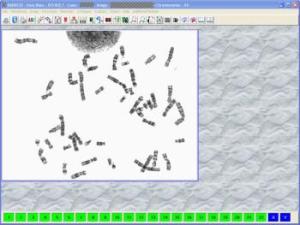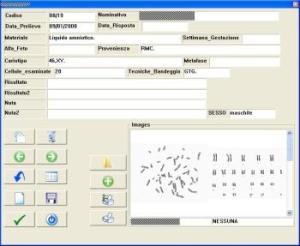DESCRIPTION
KARIO is a karyotyping software developed to support genetists during the exacting work of karyotype reconstruction. KARIO software’s development was started in 1993, and thanks to the collaboration of genetic research centers, the software has reached one of the highest levels of reliability possible in automatic Karyotype reconstruction.
KARIO has a simple interactive environment making it possible for immediate use on jobs.
All the functions are accessible from the main menu, the classical popup menus, or the more intuitive toolbar.
KARIO software was designed to reduce waiting and wasted time and to be more user friendly. The software may be fully personalized to meet your needs. You can choose which functions you would like available to you on the toolbar or which views you would like to see in the application window (metaphase and karyotype images or karyotype layouts).

THE CLINICAL CASE
A new work philosophy is the basis of KARIO. No longer are you limited to simple images stored on your hard disk; you now have the “clinical case” file feature. In the “clinical case” file you can store all patient textual data, all metaphase images, and all karyotype images together.
The “clinical case engine” constitutes a powerful database, in which you define each input field, arrange the placement of the fields on the interface, and may search just one input field or several.

IMAGE ACQUISITION
There are 100-image storage spaces available for you to store metaphase images during slide screening, or you can save the multiple images of high spread metaphase (this is usually performed before montaging them in to one image).
When you have to acquire a metaphase image, the software shows you a “LIVE image”. This allows you to focus, increase contrast and brightness, or move around the slide before going on to capture the image.
You have many functions available to help you process and enhance images after acquisition, which makes it possible for you to achieve the highest bands contrast under every condition.
KARIOhas an electronic "scissor" that allows you to easily separate touching or overlapping chromosomes.
4 WAYS OF KARYOTYPING
KARIO has 4 ways of reconstructing a karyotype:
-
You can perform a “Label Karyotyping” on the metaphase image. It is not a full karyotype reconstruction, but it is useful when you want to point out only a few chromosomes.
-
In the “Free Karyotyping” mode you select a chromosome with a simple mouse click, then click on the desired “class box”. This places the chromosome in the class category you have selected.There is no order to follow when you are classifying them, you can classify the chromosomes in the order you identify them.
-
In the “Aided Karyotyping” mode the software asks you to identify the chromosomes in ordinal order. This limits you task to finding the chromosome asked for in metaphase and clicking on it.
-
In the “Automatic Karyotyping” reconstruction the software analyzes all of the chromosomes in metaphase, and according to the “knowledge database” it reconstructs the karyotype. The “knowledge database” is an auto-learning collection of chromosome data. All the information in the knowledge database comes from your own images, and so they are optimized by your labs standards and techniques. The “Automatic Karyotyping” is the most sophisticated mode in KARIO software.
All reconstructed karyotype images, metaphase images, and patient data may be printed. You may use different templates depending on the images and data you want to include in your report. You can use the built in templates from KARIO software, or you can design your own.